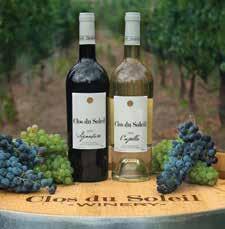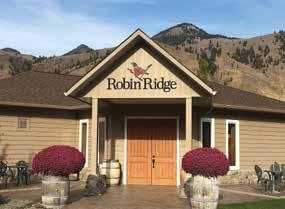
9 minute read
Similkameen Valley
BY JEANNETTE LEBLANC

Advertisement
Similkameen Valley The resilient, remarkable,

n early sun crests the rocky range as Mount Chopaka greets a new day, her silhouette shining over the valley below. Life stirs slowly, on ranches and at vineyards and in orchards, breathing into the land a persistent energy. This is the Similkameen Valley on an elemental level. There’s a transcendent beauty to it, one echoed in the character of those who call it home.
A
“If we don’t know where we come from, we don’t know where we are going.” Lower Similkameen Indian Band
Before roads or rails, and prior to the expansion of the Hudson’s Bay Trading Company and the Gold Rush, it’s estimated 800 to 1,000 Smalqmix (of the Sukwnaqin-x) made the first encampment in what’s now Keremeos. Today, there are 11 reserves totaling 15,000 hectares over 90 kilometers. The descendants have an active Band and engaged community.
Forged eons ago by volcanic activity and glacial flooding, the region is rich with mineral deposits. The Similkameen River, with headwaters in Manning Park, and fertile soils attracted first ranching, farming, and then viticulture. It feels remote while still being accessible, and most want to leave a low environmental footprint.
Hot summers means the Similkameen is ideal for tree fruits and viticulture. As early as 1916, at least one larger fruit grower mailed recruitment brochures across Canada with the promise a company town would be built for family settlers. By the 1960s, the valley was an organic farming hub and vineyards appeared around the 1980s. Some fruit growers crossed over, and every year brought more acres planted to vines. Organic practices and certifications were, and continue to be, common.
By the early 2000s, some eager


vintners were priced out of land in the Okanagan Valley and turned their sights to the Similkameen. A handful of wineries grew into a tidy little wine region, large enough to form the Similkameen Winegrowers Association in 2009. The area now has 700 acres of vineyards with more than 14 wineries and cideries.
John and Virginia Weber visited the Similkameen in 2001, leaving Saskatchewan to plant roots here and start Orofino Vineyards when few British Columbians knew this was a wine region. With almost 20 years here, John is the person newer winery folks call when they have questions. He and others often gather and compare their wines to those around the globe.
If one word could describe this region it’s resilient. Farming is far from an easy life. The ranch with 150 cattle struggles to find skilled wranglers when cows need to go to summer pasture. Wildlife can wreak havoc on farms and crops. And farms are part of the Agricultural Land Reserve (ALR), designed to help preserve arable land but being a bit of a blunt instrument when farmers need to navigate legislation for improving their businesses.
For example, Untangled Craft Cider and the Row Fourteen field-to-plate restaurant are part of Klippers Organics, started by Annamarie and Kevin Klippenstein in 2001. Looking to grow their business, they wanted to open a restaurant and then a cidery but licensing requirements meant the cidery had to come first—so they changed course and combined the projects to realize their plans.
Even responsible growth brings change. Similkameen River water levels are anecdotally lower, and algae blooms increasingly common. More farming means more fences and impacts wildlife migration patterns, part of a healthy ecosystem. Some change is unexpected, like a global pandemic that’s affecting us all; the 54th annual rodeo on Easter weekend didn’t proceed as planned. Wineries and cideries ready to welcome visitors in April are scrambling for new summer business strategies. Resilience here is key.
At the time of writing, the world we thought we knew is changing into something we might not easily recognize—perhaps forever. Those businesses we support now will have the best chance, and the steps we take today become the trails we walk tomorrow.
While we must wait to explore the world again in person, we can still sign up to receive newsletters, engage on social media, or join a winery’s wine club. In Alberta some retail wine shops already carry these wines, although smaller winery labels can be more difficult to locate.
The future might be uncertain, but it’s people like these we want to have waiting for us when we find it together.

The groundbreakers
Clos du Soleil, est 2006 Small production dedicated to minimal intervention winemaking with biodynamic viticulture. Clos du Soleil is derived from the French meaning ‘an enclosed vineyard of the sun.’ To try: Capella, Signature (white or red Bordeaux variety blends respectively).
Crowsnest Vineyards,est 1995 One of the first Similkameen wineries, the Heinecke’s adult children Sasha and Ann (winemaker) took over in 2017. The winery has an onsite restaurant with patio, a bakery, guest rooms, and distillery license. To try: 2019 Chardonnay, 2019 Riesling, 2019 Rosé.
Forbidden Fruit Winery,est 2004 Steve Venables bought and planted the property in 1977, meeting wife Kim Brind’Amour in 1981 on the farm. They certified organic in 1984 and make fruit wines, grape wines, and three ciders. To try: Pearsuasion Dry Pear, Dead End wines or ciders.
Orofino Vineyards,est 2001 John and Virginia Weber built Canada’s first strawbale winery, now 100% solar powered and with guest suites. Their focus is on vineyard-specific wines built to age. The recently acquired Passion Pit vineyard will see more Syrah planted, a very good thing. To try: riesling, gamay, syrah, cabernet franc, Beleza (blend).
Eau Vivre Winery,est 2009 Owners Sukh & Neetu Bajwa purchased this established winery in 2018 so that Sukh could pursue his dream, with Anthony Buchana guiding Sukh through winemaking. To try: 2019 Syrah (natural ferment), 2019 Chardonnay.
Robin Ridge Winery, est 2006 Tim (a firefighter) and Carolyn Cottrill planted their vineyard in 1997, growing for other wineries until making their own wines in 2006. Like many here, theirs is a certified organic vineyard and winery. To try: 2016 Pinot Noir, 2016 Gamay.
Rustic Roots Winery & Cidery, est 2008 The Harkers are a fifth generation family in organic farming. Troy operates the farm and his wife Sara is the winemaker; an

original Snow Apple tree planted in 1916 still contributes today. To try: Pippin or Fameuse sparkling wines, Snow Cider.
Seven Stones Winery,est 2003 Originally from Whitehorse, George Hanson bought land in 1999 to plant a vineyard with wine production in 2003. George holds on to bottles for a few years prior to release, and we thank him for it. To try: Row 128 Merlot, Chardonnay, Meritage.
Somewhat more recent additions
Corcelettes Estate Winery,est 2011 Charlie and Jesce Baessler purchased their current property in 2015, expanding 21 vineyard acres to 30 and adding 160 this year. The new site gives opportunity to experiment with higher elevation growing. Annual production is around 5,000 cases. Try: 2019 Oracle Rosé, syrah, cabernet franc.
Hugging Tree, est 2011 Retired former RCMP officers Walt & Christine Makepeace moved from their first 60-acre location to a smaller 32 acres
Corcelettes Estate Winery



over two sites, planting new vineyards and building a new winery for 2020. Son Brad is the winemaker, and last year Walt was the employee of the month every month.
Liber Farm & Winery, est 2016 Mike and Nicole Dowell moved their family from Edmonton to fully embrace organic living. Their sevenacre organic vineyard is equal parts chardonnay and merlot, and the winery received certification in 2018. Try: both chardonnays (especially the Grand Estate Reserve).
Little Farm Winery, est 2009 Rhys Pender and Alishan Driediger (winemaker) purchased land in 2009 and produced their first vintage in 2011. Named for the French term paysan (small farmer), the focus is on creating interesting wines of character. Try: riesling, chardonnay, basically the entire Pied de Cuve series.
Twisted Hills Cider, est 2012 Jo Schneider and Kaylan Madeira purchased 12 acres of land in 2008, mainly for organic cider apple growing. The ‘CiderDome’ opened in 2012. Jo manages the farm, Kaylan is the cidermaker, and both do absolutely everything. Try: Kingston’s Twist, Pippin’s Fate, or just about anything.
Untangled Craft Cider, est 2019 Annamarie and Kevin Klippenstein began Klippers Organics in 2001. Their 50-acre farm is certified organic and tended entirely by hand. Last summer they opened a stunning farm restaurant Row Fourteen, designed by architect Norman Goddard, with a tasting room for the cidery. Try: Tangled or Hopped Apricot ciders.
Vanessa Vineyard, est 2012 Suki Sekhon and John Welson purchased 75 acres of rocky, sloped grazing pasture in 2008 and began planting the five varieties used for their estate wines. They added Howard Soon as master winemaker and made their first vintage in 2012. Try: syrah, cabernet franc, viognier, meritage.
Jeannette is freelance writer with a focus on sharing the stories of a place and its people. She lives in British Columbia’s Okanagan Valley, and is happiest with a glass of bubble in hand.
We’ve launched a series of high quality, paired dinner packages for you to enjoy at home, with a video to take you through the dishes and pairings! The hot dishes are ready for you to cook and finish, so they’re as delicious as they would be in the restaurant.

Alforno Paired Pizza Package A three-course meal, which includes house-made dough, fixings, and toppings for you to make your own Margherita, Fun Guy, or Pepperoni pizza! An appetizer, dessert, and a surprise are included too! Wednesdays
Franca’s Italian Pasta Package Mario and Franca’s delicious fourcourse pairing meal includes a hot pasta course from their hometown in Italy for you to cook at home! A starter, dessert, and additional baked goods are also included. Wednesdays
Hotel Arts Raw Bar Dinner Package In his inimitable style, Executive Chef Quinn Staple has put together an outstanding four-course pairing dinner menu, with a braised beef short rib main course for you to finish at home. Thursdays
Moonlight & Eli Fondue Package Spoil yourself with a sparkling paired Appenzeller and Jarlsberg cheese fondue, and 10 dipping items, followed by Sweet Bella Earl Grey Chocolate Fondue and more dipping items! Wednesdays/Thursdays
All packages are available in very limited quantities for contactless pick up at the restaurant on designated days each week. For full details, check out culinairemagazine.ca/VandD and contact linda@culinairemagazine.ca 403-870-9802 to reserve your package!










